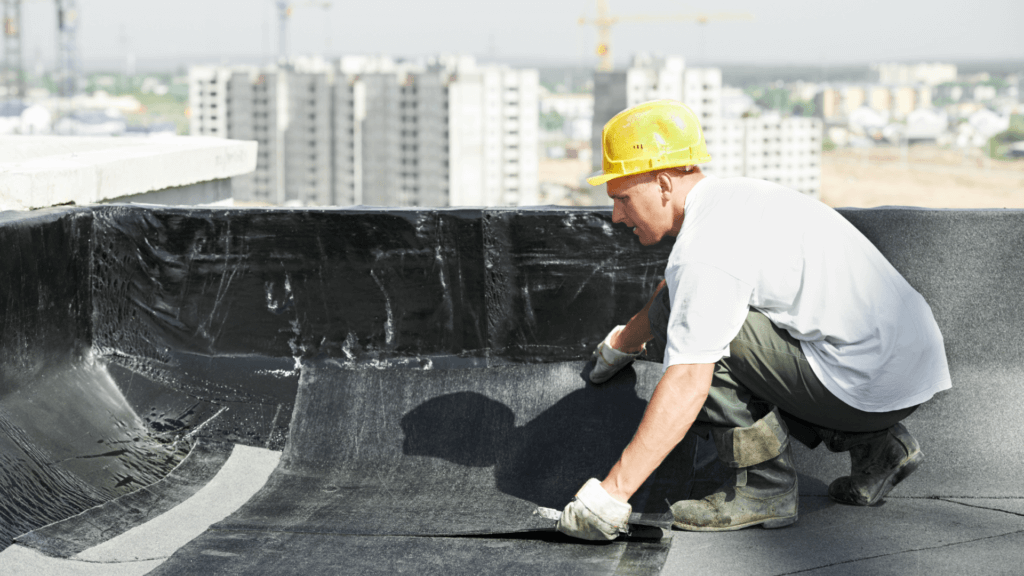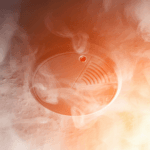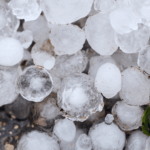
Business owners must deal with many day-to-day responsibilities when owning and/or operating a commercial property. This is especially true when it comes to severe weather. Having damage to a commercial property after bad weather or a natural disaster event can be particularly frustrating to deal with and can greatly impact a business’s bottom line. One of the most common types of weather-related damage that can occur to a commercial property is roof damage from hail. Understanding the ways to identify hail damage can help business owners quickly take the measures they need to mitigate further damage and ensure an insurance claim is filed quickly.
Texas Commercial Hail Damage
When severe weather events like thunderstorms occur, they can create hailstones of varying sizes. Hailstones are formed in powerful thunderclouds with powerful updrafts, similar to those that can cause tornadoes. These updrafts push water droplets through the clouds. When these layers of clouds also have temperatures of zero degrees Celsius or 32 degrees Fahrenheit, the droplets will freeze and become small ice granules that can accumulate more ice as they travel – creating hailstones.
Hailstones will fall to the ground once they become too heavy for the updrafts to keep them aloft. In the United States, hailstones become destructive once they measure between 2.5 centimeters and 4.4 centimeters. While smaller hailstones can be more of an annoyance, larger ones have the potential to significantly damage property.
Texas, in particular, is no stranger to the dangers hail can bring. According to the Insurance Information Institute, in 2023 over 6,500 hail events occurred in the U.S., with Texas having the largest number of hail events at 1,123. This number has slowly increased over time; in 2019, the state also experienced the most hailstorms and resulting damage with 872 significant hail events.
A Texas storm that impacted the Austin area in September 2023 resulted in the costliest hail damage the region has ever seen, with losses that spanned across two counties, adding up to $600 million. Further north in the Dallas-Fort Worth area, a June storm caused an estimated $7 billion to $10 billion in insured losses, with 95% of the loss attributed to hail.
Damage from a hailstorm can be incredibly serious, particularly for businesses, as it often results in hundreds of millions of dollars in lost property, equipment, crops, and much more.
While bouts of hail can happen at any time, hailstorm formation requires severe thunderstorms fueled by warmth and humidity. Because of this, hail season generally begins in the spring and summer months and tapers off around the fall. The area known as Hail Alley covers a large portion of North and West Texas and stretches across the plains – greatly impacting major cities like Dallas.
Identifying Hail Damage
When determining if a commercial property’s roof has suffered hail damage, it’s important to do it safely. An experienced roofer can evaluate the damage and provide a report based on their findings, which property owners can use when filing an insurance claim for the damage.
While hail can be destructive in most circumstances, certain factors can affect both the type and degree of damage to a property’s roof, including:
- Wind direction: Wind direction and wind speed during a hailstorm can vary. Changes in these conditions can impact both the location and severity of hail impacts.
- Size and density: The size of hailstones can affect the severity of property damage. While a hailstone can be as small as a pea, it can also be as large as a softball (or larger).
- Roofing materials and age: Different materials used in constructing and/or repairing a roof can absorb the impact of a hailstone differently. For instance, hail can cause dings in aluminum materials, gutters, or asphalt, whereas it can crack vinyl or wood. Additionally, the age and condition of a roof could affect the degree of damage. If a roof suffered prior storm damage, it could be weak enough for a hailstone to puncture.
- Property barriers: The positioning of neighboring buildings and natural barriers, like tree cover, landscaping, or adjacent properties, can reduce the ability of hail to damage a business.
When determining if a commercial property’s roof has suffered hail damage, one of the most obvious signs is a leaky roof. There could be water dripping from AC units into the building, water markings on the ceiling, or even mold in some cases. When looking at the exterior to determine the extent of hail damage, commercial property owners should be sure to check the following:
- Gutters: When a property has dented or damaged gutters, it is often an indicator that hail damage is present on the roof. This can be apparent if there are obvious dents and scratches on the gutter, gutter screens, and downspouts.
- HVAC systems: For many commercial properties, heating, ventilation, and air conditioning (HVAC) systems are located on the roof. If it seems the HVAC system is not working properly, like there is irregular heating and/or cooling of the building, it could be due to hail damage. This is because hail can impact the system’s thin metal slats that direct airflow. If these are damaged, airflow can be constricted.
- Asphalt and tar roofs: Asphalt buildup and tar and gravel roofs make it difficult to determine if hail damage is present. A sample will need to be taken after the gravel has been swept off and sent to a specialist to determine damage.
- Modified bitumen roofs: It is relatively easy to notice hail damage on modified bitumen roofs, as the product is very similar to modified asphalt shingles on a home. Dark circular or star-shaped patterns in the areas where the hail has impacted the roof membrane indicate hail damage on your roof.
- EPDM rubber roofs: If an EPDM rubber roof has suffered hail damage, it will most likely have dimpled or damaged the insulation board under the roof membrane, which can cause water to pool on the roof. If this occurs, the roof will need to be removed entirely and replaced with new insulation and a new membrane.
- TPO and PVC roofs: Depending on the size of the hail and the age of the roof, a TPO or PVC roof can make it difficult to detect hail damage. In many cases, the damage won’t be present on the roof’s surface but will be present on the bottom of the roof membrane, which shatters the reinforcement in the middle of it. This allows water to enter the membrane, making it extremely difficult to find roof leaks as they can’t be seen on the surface.
Common Hail Damage Myths
While determining if a business’s roof has suffered hail damage can seem straightforward, there are several myths property owners may believe to be true that should be avoided. These include:
Not Filing an Insurance Claim Because the Damage Doesn’t Appear Significant
After any hail event, business owners must schedule an unbiased commercial roofing inspection as soon as possible. These inspections require specialized knowledge to confirm the extent of damage that may be difficult for owners to detect. While it’s not uncommon for an insurance roofing inspector to disregard seemingly minor damage, it’s important to note that even the smallest amount of damage can worsen over time. Not only that but if a property is not well-maintained and suffers significant damage down the road, insurers may deny a claim for property damage, as it is the owner’s responsibility to ensure their structures are in tip-top shape.
Newer Roofs are Covered Under Warranty from the Material Manufacturer or Building Contractor
Just as with a commercial property policy, if a commercial property owner obtains a warranty for a newly installed roof, they must read the fine print. This is because most roofing manufacturers commonly exclude hail damage from their warranty coverage.
The Property Owner Can Fix a Hail Damaged Roof on Their Own Without Filing an Insurance Claim
Because not all roofing systems are built the same, it’s important for commercial property owners to ensure any damage sustained is properly addressed by both the insurance company and an experienced roofer. While flat roofing systems can be very effective, their components must be properly maintained and require particular skill sets to ensure lasting results. Property owners who attempt to self-repair can often make an already difficult situation much worse by inadvertently causing more damage.
How To Protect A Commercial Roof Against Hail and Storm Damage
For commercial property owners, securing your properties before a hailstorm, hurricane, or other severe weather event is a common step in storm preparation. However, even thunderstorms and unexpected rain showers can cause damage to a property’s roof, which is one of the most expensive components of a commercial structure. Roof damage can lead to leaks, which can impact the interior of a property. Ensuring that roof systems are intact before a storm can aid in minimizing and managing damage when it does occur.
Some of the most effective ways to prepare a commercial property’s roof before a storm include:
Inspect Roof Drainage Systems
The roof drainage systems of a commercial property should be regularly inspected throughout the year. During any bout of rain, thousands of gallons of water can be dumped onto a roof. Because many commercial properties’ roof systems have a low slope, water needs to be able to reach the drains. If water exits the roof through overflows and runs down the exterior of the building, it could indicate a drain in that area is inoperable or a downspout is blocked. If this occurs, it should immediately be reported to a contractor or roofing consultant to avoid any further water damage.
Consider Wind Causing Water Entry
When a severe storm occurs, it can have wind speeds as high as 35 miles per hour. While roofing membranes on commercial structures should be watertight, HVAC units, vents, stacks, and skylights have openings, which can lead to water unexpectedly entering the building. Typically, these rooftop penetrations are designed to remain effective against rain that comes straight down or at a slight slant; however, more intense winds can blow the rain sideways. If this happens, water can more easily enter the building and cause a leak to occur. The potential for this to happen should be considered by commercial property owners well before a storm begins to avoid possible interior damage.
Mitigate Interior Damage
In any commercial property, the most significant items that contribute to running the business are typically located inside the building, so it is crucial to avoid interior damage. When preparing a roof before a storm, property owners should locate their HVAC registers and move anything of value, such as computers, documents, or hard drives that are under the registers. This is especially important if there is already the potential for a roof leak to occur, as roof leaks or ruptured pipes can transfer water into a building’s air ducts. The ductwork installed on the roof often lacks a watertight seal, which allows a pathway through the seams and into the interior ducts and vents. Additionally, if a commercial property has any materials located under any type of vent, HVAC register, or louvered skylight that cannot be moved, they should be properly covered.
Know the Location of a Leak
Roofing contractors are often called to repair leaks to windows, doors, or walls, or leaks under a building’s foundation. If you notice your property has a roof leak, engage the proper contractor to repair the leak as soon as possible. This is especially important to consider because contractors will likely be high in demand after a major storm. Knowing the right professional to contact can help to expedite the repair process and ensure the repair is successful.
Commercial Property Insurance Claim Attorneys
A hail-damaged roof can cause undue stress on business owners. While being prepared for the potential of further roof damage or leaks can help mitigate the aftermath of a storm, it’s also critical for commercial property owners to have the proper insurance coverage in place. In doing this, it’s best to consult with an insurance coverage attorney with the knowledge and insight to properly assess a commercial policy and identify any possible gaps in coverage. Additionally, in the event a valid insurance claim for roof damage is denied, having the right legal counsel can help your business hold insurance providers accountable and get you the financial compensation you need to restore your operations.
At Raizner Slania, our team of experienced commercial property insurance claim attorneys is aware of the many ways insurance companies attempt to undermine the claims process to turn a profit for themselves. These companies may try to delay, underpay, or deny valid claims entirely to the detriment of their policyholders.


